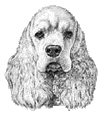 Entropion
Entropion
![]()
|
|
|
|
This is a condition in which the lower lid margins roll inward to the extent that hair rubs on the surface of the eyeball. In rare cases the upper lid can also be affected to some degree. One or both eyes may be involved. This condition can occur in all breeds, however Spaniels, Great Danes, Shar Peis, Poodles and Saint Bernards seem to be the most frequently affected breeds, suggesting an inherited trait. What are the symptoms?Most dogs with entropion will squint and have a reddened, inflamed eye. Because of the pain involved, dogs will scratch at the eye with a paw, possibly doing further damage. Examination of the lower eyelid will confirm the diagnosis. What are the risks?Left untreated, severe eye infections may develop. The cornea can become severely irritated or damaged as the chronic abrasion by the inverted lower lid wears away at it surface. In some cases, deep ulcers form in the cornea, even to the point of rupturing through its surface. This quickly leads to intraocular infections and potential blindness. What is the management?Once diagnosed, surgery is the only treatment. There are several different techniques, but typically a small incision is made below the lid, a small portion of skin is removed and when the two sides of the incision are then sutured, it pulls the border of the lid downward into a normal position. Antibiotic ointments may be applied if infections are present. Race Foster, DVM and Marty Smith, DVM |